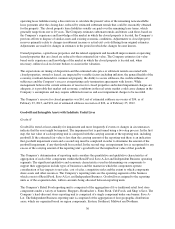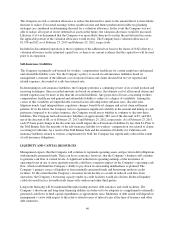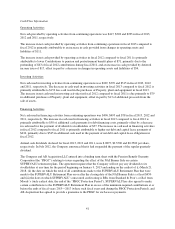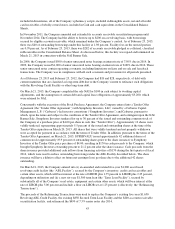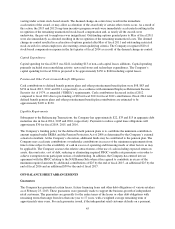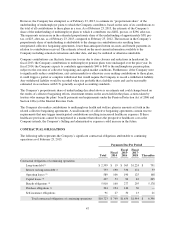Albertsons 2013 Annual Report Download - page 40
Download and view the complete annual report
Please find page 40 of the 2013 Albertsons annual report below. You can navigate through the pages in the report by either clicking on the pages listed below, or by using the keyword search tool below to find specific information within the annual report.Intangible Assets with Indefinite Useful Lives
The Company reviews intangible assets with indefinite useful lives, which primarily consist of trademarks and
tradenames, for impairment during the fourth quarter of each year, and more frequently if events or changes in
circumstances indicate the assets might be impaired. The impairment review consists of a comparison of the fair
value of the trade name with its carrying value. Fair value is measured using the relief-from-royalty method. Fair
values of the Company’s trademarks and tradenames are determined primarily by discounting an assumed royalty
value applied to projected future revenues associated with the tradename based on management’s expectations of
the current and future operating environment. The royalty cash flows are discounted using rates based on the
weighted average cost of capital and the specific risk profile of the tradenames relative to the Company’s other
assets. These estimates are impacted by variable factors including inflation, the general health of the economy
and market competition.
The Company completed the annual impairment test during the fourth quarter of fiscal 2013 for those intangible
assets with indefinite useful lives. An impairment charge of $6 was recorded related to tradenames during the
fourth quarter of fiscal 2013. Those charges were recorded in Goodwill and intangible asset impairment charges
in the Consolidated Statements of Operations.
Benefit Plans
The Company sponsors pension and other postretirement plans in various forms covering substantially all
employees who meet eligibility requirements. Pension benefits associated with these plans are generally based
primarily on each participant’s years of service, compensation, and age at retirement or termination. Effective
December 31, 2007, the Company authorized amendments to the SUPERVALU Retirement Plan and certain
supplemental executive retirement benefit plans whereby service crediting ended in these plans and no
employees will become eligible to participate in these plans after December 31, 2007. Pay increases continued to
be reflected in the amount of benefit earned in these plans until December 31, 2012.
The Company accounts for its defined benefit pension and other postretirement benefit plans in accordance with
Accounting Standard Codification (ASC) 715, Compensation—Retirement Benefits, in measuring plan assets and
benefit obligations and in determining the amount of net periodic benefit cost. ASC 715 requires employers to
recognize the underfunded or overfunded status of a defined benefit pension or postretirement plan as an asset or
liability in its statement of financial position and recognize changes in the funded status in the year in which the
changes occur through accumulated other comprehensive loss, which is a component of stockholders’ equity.
While the company believes the valuation methods used to determine the fair value of plan assets are appropriate
and consistent with other market participants, the use of different methodologies or assumptions to determine the
fair value of certain financial instruments could result in a different estimate of fair value at the reporting date.
The determination of the Company’s obligation and related expense for Company-sponsored pension and other
postretirement benefits is dependent, in part, on management’s selection of certain actuarial assumptions used in
calculating these amounts. These assumptions include, among other things, the discount rate, the expected long-
term rate of return on plan assets and the rates of increase in compensation and healthcare costs. Refer to Note
12-Benefit Plans in the Notes to Consolidated Financial Statements included in Part II, Item 8 of this Annual
Report on Form 10-K for additional discussion of actuarial assumptions used in determining pension and
postretirement health care liabilities and expenses.
The Company reviews and selects the discount rate to be used in connection with its pension and other
postretirement obligations annually. The discount rate reflects the current rate at which the associated liabilities
could be effectively settled at the end of the year. The Company sets its rate to reflect the yield of a portfolio of
high quality, fixed-income debt instruments that would produce cash flows sufficient in timing and amount to
settle projected future benefits.
The Company’s expected long-term rate of return on plan assets assumption is determined based on the
portfolio’s actual and target composition, current market conditions, forward-looking return and risk assumptions
38










